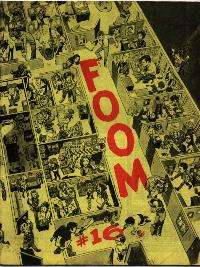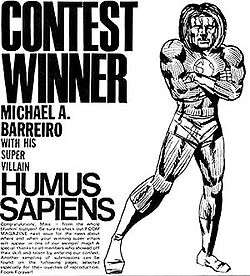FOOM
FOOM was Marvel Comics' self-produced fan magazine of the mid-1970s, following the canceled Marvelmania and preceding Marvel Age. Running 22 quarterly issues (February 1973 – Fall 1978), it was initially designed and edited by celebrated comic book writer-artist Jim Steranko.[1]
 FOOM #16 (Dec. 1976), with wraparound cover depicting the Marvel office layout at the time | |
| Editor | Jim Steranko (issues #1-4) Tony Isabella (issues #5–7) Scott Edelman (issues #8–11) Duffy Vohland (issue #12) Chris Claremont (issues #13–14) David Anthony Kraft (issue #15) |
|---|---|
| Categories | Marvel Comics news and publicity |
| Frequency | quarterly |
| Publisher | Marvel Comics |
| First issue | Feb. 1973 |
| Country | United States |
| Language | English |
FOOM, though spelled without periods in both indicia and cover treatments, is an acronym for "Friends of Ol' Marvel".[2] The name is unrelated to either the computer software acronym FOOM (Functional and Object-Oriented Methodology), or Australia's annual Songwriters, Composers and Lyricists Association (SCALA) Festival of Original Music Song Competition (FOOM).
It was relaunched in September 2017.[3]
Publication history
Steranko, in his first-issue introduction, wrote that he had "dropped in at the Marvel bullpen to rap with [publisher] Stan Lee about the current comic scene", and that Lee told him about plans to start an in-house fan club. EC Comics had had its "EC Fan-Addict" club in the 1950s, and Marvel the Merry Marvel Marching Society beginning 1964; after the MMMS had run its course by 1969, Marvel licensed a small company in Culver City, California to produce the fanzine/product catalog Marvelmania, which lasted a year. Steranko, writing that he nostalgically "recalled the days of radio, with all the clubs and super-premiums that were perpetually offered over the air", volunteered "my services as a designer, writer and comic historian". Ken Bruzenak served as associate editor, with Marvel editor-in-chief Roy Thomas as consulting editor and Ed Noonchester, Joel Thingvall, and Gary Brown as staff.
A four-issue subscription cost US$3. An additional dollar bought a club membership I.D. card, six decals, and a poster. The membership kit was also available separately for US$2.50.
The premiere contained a foreword by Lee; an introduction by Steranko announcing a contest to design a superhero or supervillain; short biographies of Lee, Thomas, artists John Buscema and Joe Sinnott, and writer Gerry Conway; three puzzles, including a crossword; a four-page feature on the superhero team the Fantastic Four, accompanied by a two-page title and credits checklist; a two-page board game, "Moving Target"; a five-page "Far-Out Fanfare and Infoomation!" section previewing upcoming Marvel comics; a pinup reprinting superheroes from the Jack Kirby-drawn cover of Fantastic Four #73 (April 1968); a page of sketches of superspy Nick Fury, on which fans were encouraged to draw disguises; a one-page "Recommended Reading" page that featured The Steranko History of Comics' and Steranko's Comixscene for two-thirds of the page; a one-page humor strip, "Fantastic Fear", written by Thomas and Len Brown and drawn by Gil Kane and Wally Wood; and two pages of in-house ads, for T-shirts and the record album The Amazing Spider-Man: A Rockomic! Similar fare appeared in subsequent issues.
Steranko, who additionally drew the back cover of issue #1 (Spider-Man), the cover of #2 (the Hulk), and incidental interior art during his tenure, was succeeded as editor by Tony Isabella with issue #5 (Spring 1974). Ed Hannigan was by now credited for production, with Mark Evanier, Jim Salicrup, and Duffy Vohland as contributing editors. Scott Edelman took over as editor with #8 (Winter 1974), Vohland with #12 (Dec. 1975), Chris Claremont with #13 (March 1976), and finally Dave Kraft with #15 (Sept. 1976). While previous issues had listed the company's overall editor-in-chief on the masthead, FOOM, also with issue #15, was given its own editor-in-chief, beginning with Ralph Macchio, followed two issues later by Salicrup.
The back cover of #7 (Fall 1974) featured one of Ghost Rider co-creator Mike Ploog's earliest sketches of that supernatural motorcyclist, introduced two years earlier. Issue #11 (Sept. 1975) was a Jack Kirby tribute commemorating the legendary comic-book artist's prodigal return to Marvel after a four-year sojourn at rival DC Comics.
John Byrne's earliest work at Marvel, a Frankenstein drawing inked by Duffy Vohland, appeared in issue #5's "Fan Art Gallery."[4]
It was relaunched in September 2017.[3]
Character contest

Issue #2 (Summer 1973) presented the first of two double-page spreads of fan art submitted for the character-design contest announced in issue #1. Included were the characters "Absorba-Man" by future comics artist Steve Rude, "Novaton" by future Marvel art director, writer and editor Mariano Nicieza and Borgo by Kazimieras G. Prapuolenis. Issue #3 (Fall 1973) included "Heros" by future Marvel Age editor Steve Saffel. The winner, announced that issue, was Michael A. Barreiro of Pittsburgh, Pennsylvania, for the supervillain "Humus Sapiens". Several dozen honorable mentions included future The X-Files comic-book writer Stefan Petrucha, listed among those under "Best Presentation".
Despite the contest's announced prize, Humus Sapiens was never used in a Marvel comic at the time.[5] Creator Barreiro later inquired at Marvel about the character, but received no response. Comics columnist Fred Hembeck in 1979 wrote in the magazine Buyer's Guide to Comic Fandom about the contest and Humus Sapiens, but nothing came of it. The character eventually appeared 28 years later in Thunderbolts #54 (Sept. 2001) and #55 (Oct. 2001), as the fictional mutant Humus Sapien. Barreiro grew up to become a carpenter and a freelance artist living in the Carrick neighborhood, and did a small amount of work for Marvel and Dark Horse Comics.[5]
References
- Brevoort, Tom; DeFalco, Tom; Manning, Matthew K.; Sanderson, Peter; Wiacek, Win (2017). Marvel Year By Year: A Visual History. DK Publishing. p. 158. ISBN 978-1465455505.
- FOOM #1 (Feb. 1973), p.2: "Once Upon a FOOM!" by Jim Steranko
- News a rama First Look: Marvel's FOOM Revival & LEGACY Launch Party Plans
- "FOOM Fan Art Gallery," FOOM, April 1974, p.24
- Sodergren, Rebecca (August 14, 2001). "Bad guy finally finishes first". Pittsburgh Post-Gazette. Archived from the original on February 22, 2011.
External links
- Ruby, Sam, ed. "FOOM Contents and Checklist: Issue #1". SamRuby.com (fansite). Archived from the original on February 22, 2011.CS1 maint: extra text: authors list (link) through "Issue #22".
- Zjaba, Tom, ed. "Marvel Comics FOOM Subscription Ad". Tomorrow's Heroes (fan site). Archived from the original on February 22, 2011.CS1 maint: extra text: authors list (link)